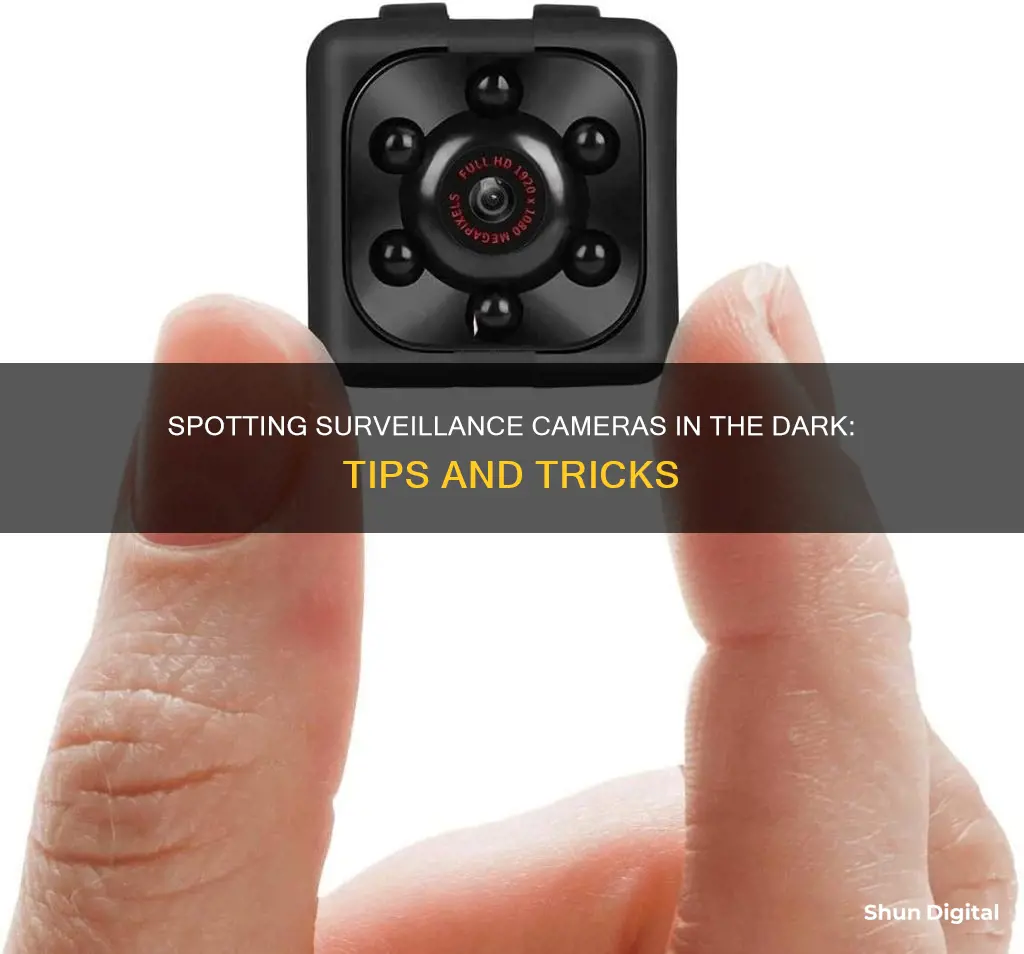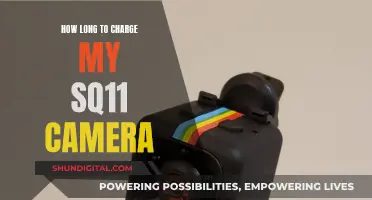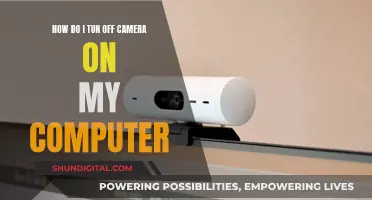
Surveillance cameras are a common way to increase security and protect possessions, but how can you spot them at night? Many security cameras have night vision capabilities, with an average range of 100 to 200 feet. These cameras use infrared LED lights, which are invisible to the human eye, to capture clear images at night. To spot these cameras, look for small red lights around the lens or use your smartphone to detect infrared lights, which typically appear purple, white, or blue. You can also scan the Wi-Fi network for unknown devices or use electronic bug detectors to find hidden cameras. Additionally, factors like lighting conditions, lens aperture, and camera resolution can affect the visibility and performance of night vision cameras.
| Characteristics | Values |
|---|---|
| Camera movement | If the camera is moving, it is likely on. |
| Lights | Look for small red, purple, white or blue lights around the lens of the camera. |
| Sound | Listen for a distinct buzz when the camera is rotating. |
| Wi-Fi | Use an app to scan the Wi-Fi network for unknown devices or devices that identify as cameras. |
| Thermal imaging | Security cameras with thermal imaging can detect heat signals and can be used for long-range nighttime surveillance. |
| Lighting conditions | Lighting conditions can impact the visibility of the camera. |
| Lens aperture | The aperture is the opening of a lens that allows light to enter. A larger lens aperture allows more light to pass through. |
| Image sensors | Image sensors are electronic devices placed inside a security camera that can receive light and convert it into electrical signals. |
What You'll Learn

Use a phone app to scan the Wi-Fi network for unknown devices
If you're looking to spot surveillance cameras at night, one of the ways to do so is by scanning the Wi-Fi network for unknown devices using a phone app. Here's a detailed guide on how to do this:
Use a Phone App to Scan the Wi-Fi Network
One of the most effective ways to detect hidden surveillance cameras is by using a phone app to scan the Wi-Fi network for unknown devices. This method works for both Android and iOS devices, and there are several apps available that can help you with this task. Here's a step-by-step guide:
- Download a Wi-Fi Scanning App: Look for a reliable Wi-Fi scanning app that can help you identify all the devices connected to your network. Popular options include Fing, Network Analyzer Lite, and Hidden Camera Detector. These apps are usually available for free on the App Store or Google Play Store.
- Grant Necessary Permissions: When you open the app, it may ask for certain permissions such as location access. Grant the necessary permissions to ensure the app functions properly.
- Disconnect Other Devices: For more accurate results, it is recommended to disconnect all other devices from the Wi-Fi network except for the phone or tablet running the scanning app. This will make it easier to identify any unknown devices.
- Initiate the Scan: Start the scanning process within the app. Depending on the app, you may need to press a "Refresh" or "Scan" button to begin. Wait for the app to finish scanning the network.
- Analyze the Results: Once the scan is complete, the app will provide you with a list of all the devices connected to your Wi-Fi network. Look for any devices that seem unusual or unknown. Pay attention to devices with names that could be associated with cameras, such as "IP Camera" or names from camera manufacturers like Nest, Arlo, or Wyze.
- Investigate Further: If you spot any suspicious devices, make a note of their IP addresses. You can then use additional features within the app or other methods to scan for open ports and identify the purpose of these devices.
By following these steps, you can effectively use a phone app to scan your Wi-Fi network for unknown devices, potentially revealing the presence of hidden surveillance cameras. Remember to cross-reference the devices found with common items such as printers, which may also show up as unknown.
Wi-Fi Doorbell Cameras: Battery or Wired Power?
You may want to see also

Check for infrared lights using your phone camera
Checking for Infrared Lights Using Your Phone Camera
Infrared lights are invisible to the human eye, but they can be detected by your phone camera. This is because, although most cameras are designed to capture what the human eye can see, the charged couple devices (CCDs) within cameras are manufactured to pick up infrared light.
How to Check for Infrared Lights
To check for infrared lights, follow these steps:
- Open your phone camera: You can use the default camera app on your phone, or you can download a hidden camera detector app. If you are using an iOS device, the app will always open the front camera as Apple has applied an IR filter to the back cameras.
- Scan your surroundings: Carefully inspect the camera preview for any white or blue lights that are invisible to the naked eye. These lights indicate the presence of infrared lights. Scan the entire room by moving your phone 360 degrees and also look at the ceiling, vents, and outlets.
- Identify the source of the infrared lights: There could be many devices emitting infrared lights, not just cameras. For example, it could be the reflection of your phone's IR blaster in a mirror or a TV remote control. If you suspect a camera, look for a lens and ask the premises owner for more information.
Testing Your Phone Camera
You can test your phone camera's ability to detect infrared lights by pointing it at an infrared light source, such as a TV remote control. Press a button on the remote, and you should see a flash of light on your phone camera screen.
Limitations and Alternatives
While your phone camera can detect infrared lights, it is also sensitive to visible light, which may drown out the infrared image. Therefore, you may not be able to see the world in true infrared without additional infrared filters.
Additionally, some smartphones have filters to block out infrared light on their primary camera, so you may need to use the front-facing camera instead. To determine which camera works best, grab an infrared remote and point it at each camera, pressing a button to see if the light is detected.
Alternatively, you can use electronic bug detectors or scan the Wi-Fi network for unknown devices that identify themselves as cameras.
Action Camera Car Mode: What's the Deal?
You may want to see also

Look for the red light on security cameras
When trying to spot a surveillance camera at night, one of the most important things to look out for is a red light. This is because many security cameras have small, red lights on either corner to indicate that they are actively recording. These lights serve two main purposes: debugging and showing the presence of a camera.
The red light on a security camera means that the camera is connected to a power supply and that the footage is being sent to the receiver. These lights can be disabled, and the camera will continue to record. However, the presence of the red light acts as a warning to anyone with malicious intentions against a protected property.
Another type of red light to look out for is the red infrared (IR) light used for night vision. These emit a red light that is invisible to the human eye but can be seen by the camera's image sensor. This type of red light is harder to notice and appears dim.
To spot a security camera at night, you can use a smartphone to look for infrared lights. While infrared rays are invisible, many smartphones can detect them. You can test this by pointing an infrared remote at your phone and pressing a button. If you see the light on the screen, your phone can detect infrared. Once you've determined this, turn off the lights and look for any glowing lights with your phone's camera.
It's important to note that not all security cameras have red lights, and some may use different coloured lights or no visible indicators at all.
Understanding Camera Lenses: Integrated Focus Feature Explained
You may want to see also

Check for movement in pan and tilt security cameras
Pan and tilt security cameras, also known as PTZ cameras, are ideal for surveillance as they can rotate left and right, tilt up and down, and zoom in and out. They are robotic cameras with motorized zoom lenses and the ability to move.
If you have installed a pan and tilt security camera, you can easily spot it at night by observing its movement. These cameras rotate continuously when they are on, and you will hear a distinct buzzing sound when they are rotating. If you have set up the patrol or tour function, you will see the camera moving constantly, which indicates that it is on.
- Observe the rotation: Pay attention to any continuous rotation or movement in the camera. If it is a pan and tilt camera, it will have the ability to rotate left and right and tilt up and down. Look for any patterns or cycles in its movement.
- Listen for a buzzing sound: Pan and tilt cameras often make a distinct buzzing sound when they are rotating. This sound may be more noticeable at night when there is less background noise.
- Check the patrol or tour function: If you have intentionally set up a patrol or tour function, the camera will move constantly along a predefined path. This movement will be more noticeable at night, especially if the camera has lights or makes a sound during operation.
- Use a smartphone app: Many pan and tilt cameras can be controlled remotely via a smartphone app. Download the appropriate app and try to connect to the camera. If it responds to your commands and moves accordingly, it is likely operational.
- Compare with similar cameras: If you have multiple pan and tilt cameras or access to similar models, compare their movements. Observe if they rotate or tilt in a similar manner, especially when activated or during specific functions.
- Check the camera's specifications: Refer to the camera's user manual or specifications to understand its movement patterns, speed, and any preset functions. This information can help you identify if the camera is operational and functioning as intended.
Surveillance Cameras: Aiding Police, Fighting Crime
You may want to see also

Listen for a distinct buzz in rotating security cameras
If you have a pan-and-tilt security camera, you will be able to hear a distinct buzz when it rotates. This buzzing noise is often louder than the sound the camera makes when panning. If you have recently purchased a security camera and are unsure whether it should be making a buzzing noise, you can ask for advice on online forums or contact the manufacturer directly.
If you are experiencing a buzzing noise from your security camera, it could be due to a number of reasons. Firstly, the camera may have an internal fan, which can be checked by opening up the camera and looking inside. If the fan is loose and vibrating, it could be the source of the buzzing noise. Another possible cause is the camera's power supply; try using a different power supply to see if that changes the noise level.
If you are experiencing a buzzing noise when viewing your security camera footage through an app, it is likely a different issue. This could be due to a problem with the camera's speaker, which can be resolved by disabling the speaker function or turning down the volume.
Camera Battery Basics: What Photographers Need to Know
You may want to see also







